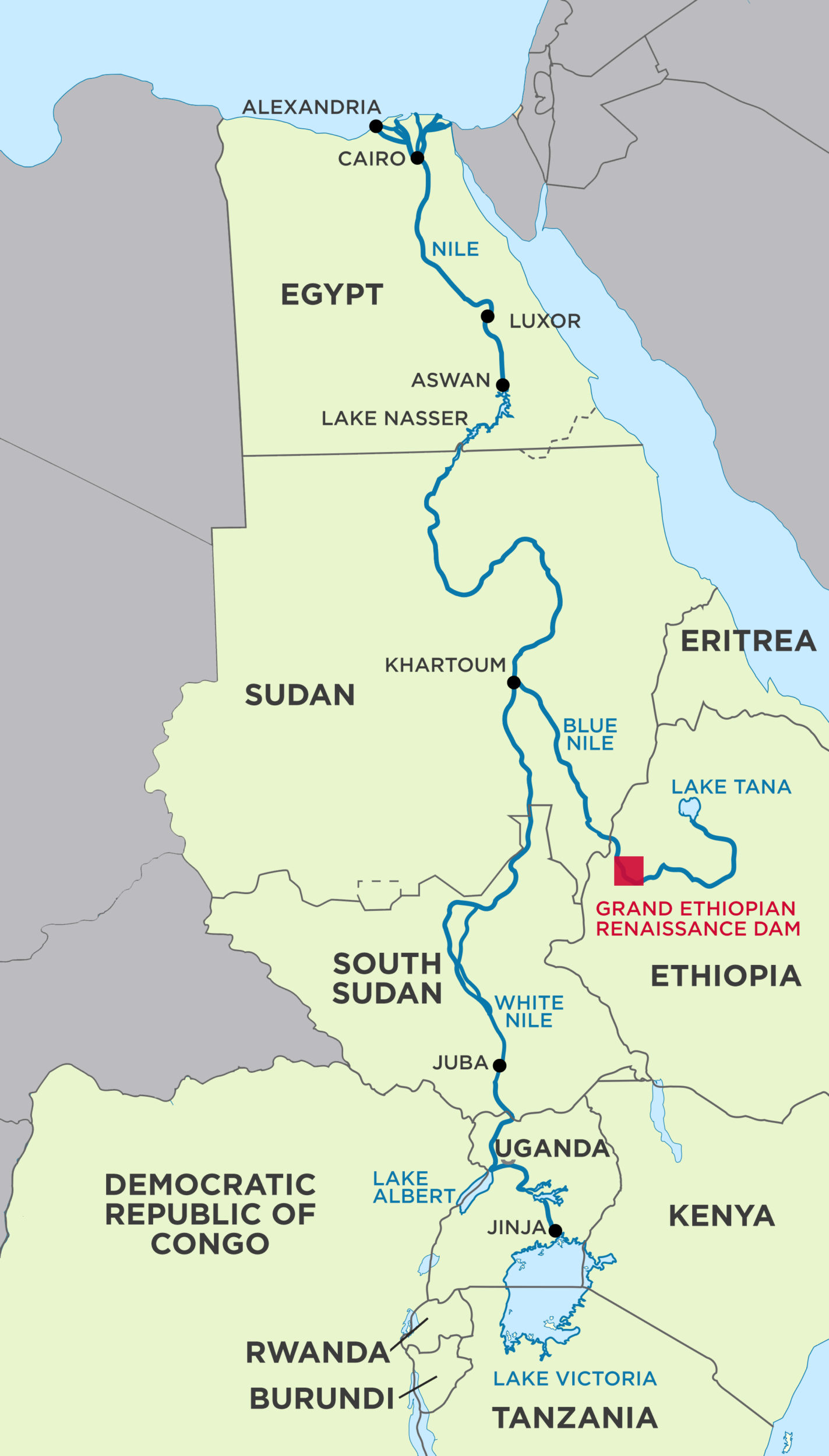
History of the Nile River
For decades Egypt and Ethiopia have been in conflict over the Nile river. With the Nile river flowing from south to north, the Blue Nile stems in Ethiopia and travels through Sudan before finally reaching Egypt. Since Egypt and Sudan are at the end of the Nile, laws were set in place to protect their rights to the water. These agreements are known as the Nile River Agreements and were signed in 1902, 1925, and 1959. 1959 is also the year when the water disputes began. For decades Egypt had been holding down its foot and vetoing Ethiopia’s Dam idea, a right that Egypt has through the Nile river agreements.

Potential Consequences of the Dam
If the Grand Ethiopian Renaissance Dam is built and filled within Ethiopia’s target six year plan, the severity of the drought would demolish Egypt’s economy. It is estimated that a water deficit of that magnitude could potentially destabilize a politically volatile part of the world by reducing fertile land in Egypt by up to seventy two percent. The study projects that economic losses to agriculture would reach over fifty billion dollars. Such a number could lead to a gross domestic product (GDP) loss that would push unemployment to about twenty four percent. The effects would displace many people and completely disrupt the economy. These economic hits would cause the already demolishing democracy in Egypt to take a much stronger hit.
How did the Ethiopian-Egyptian water conflict reach this point?
Lack of Control
On January 25th, 2011, the Arab Spring began in Egypt and the entire country was in an uproar as they protested to overthrow the former president, Hosni Mubarak. The lack of governmental control or focus on external affairs caused Egypt to be distracted and lose focus of the water crisis with Ethiopia. In 2011, Ethiopia began the construction of the Grand Ethiopian Renaissance Dam taking advantage of the state of Egypt during the time.
Now in 2022, despite having a strong leader, Egypt and Ethiopia are in a power struggle and Egypt lost the upper hand in the argument and is now left at the sovereignty of Ethiopia. This is because Egypt lacked the leadership that it needed back in 2011.
Thus, the consequences of the democratic state of Egypt in 2011 are still evident and arguably very detrimental, even over 11 years later. Egypt is an example of a state whose democratic erosion is exponential.
Future Effect on Democracy
Such threats to Egypt’s economy also pose a threat to Egypt’s democracy. From the Acemoglu, Daron, and James Robinson. 2006. Economic Origins of Dictatorship and Democracy, Economic Origins of Dictatorship and Democracy, we learned that social conflict for the sake of democracy is demanded by the disenfranchised rather than the elite. The unemployment rates, in accordance with Acemoglu and Robinson’s claim, would set Egypt up for yet another social conflict, and yet another backsliding.
Sources Cited
Acemoglu, D., & Robinson, J. A. (2012). Economic origins of dictatorship and democracy. Cambridge University Press. https://doi.org/10.1017/cbo9780511510809
Al-Anani, K. (2020, June 16). Water conflict between Egypt and Ethiopia: A defining moment for both countries. Arab Center Washington DC. https://arabcenterdc.org/resource/water-conflict-between-egypt-and-ethiopia-a-defining-moment-for-both-countries/
Grand Ethiopian Renaissance Dam project, Benishangul-Gumuz. (2015, February 3). Water-Technology.Net. https://www.water-technology.net/projects/grand-ethiopian-renaissance-dam-africa/
The Editors of Encyclopedia Britannica. (2021). Arab Spring. In Encyclopedia Britannica.
Polakovic, G. (2021, July 13). Water dispute on the Nile River could destabilize the region. USC News. https://news.usc.edu/188414/nile-river-water-dispute-filling-dam-egypt-ethiopia-usc-study/

I think this brings up a really good point about the interconnectedness of economic conditions with the likelihood that democracy can succeed. I think what is also worth noting about this is how difficult it is to enforce international law. People advocate for greater international cooperation through organizations like the UN but I think this conflict demonstrates the imperfection in this approach. That is, if Ethiopia makes the calculation that building the dam is in their best interest there is little that a country like Egypt could do. There is no mechanism to enforce international law which makes it easy for something like this to happen. This is something that the international community really needs to figure out if we want countries to comply with these types of agreements and other democratic norms.
Hi Rose, I never thought about the impact that the GERD could have on Egypt’s already fragile political system. A binational water sharing agreement is definitely needed in order to reduce conflict between Egypt and Ethiopia, and I think a deal in which both parties have partial control and say over how quickly water is filled and released could prove economically beneficial to both parties. Egypt has historically refused to participate and ratify water-sharing agreements with the other Nile river states, but hopefully the threat of instability finally pushes for the states to come to an agreement.